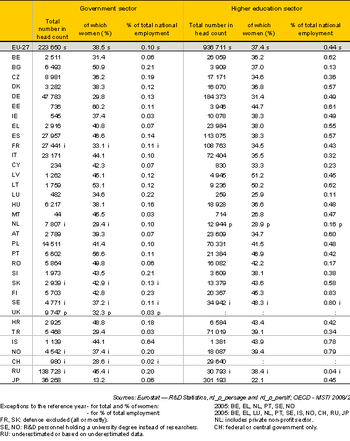Archive:Researchers in the European countries
- Data from 2007, most recent data: Further Eurostat information, Main tables and Database.
A portrait of government and higher education researchers in European countries
Research in the government and higher education sectors (GOV and HES), are mainly financed by public funds, and therefore less oriented towards profit. It can thus be assumed that these sectors attract researchers with slightly different career objectives than researchers employed in the business enterprise sector. Of the four R&D performing sectors, the higher education sector still employs most researchers at EU level, although the business enterprise sector has gradually been catching up. As a share of total employment, the highest levels of researchers working in the government and higher education sectors in the EU were recorded in Finland. In Luxembourg, the proportion of young researchers in these two sectors is very high, whereas in other countries, such as Latvia, the researcher community working in the government and higher education sectors is relatively old. In most countries for which data are available, the vast majority of researchers are citizens of the country of employment. However, Luxembourg, Switzerland, Cyprus and Denmark counted more than 10 % of foreign researchers in the higher education sector. In most countries for which data are available, the vast majority of researchers are citizens of the country of employment. However, Luxembourg, Switzerland, Cyprus and Denmark counted more than 10 % of foreign researchers in the higher education sector.
Main statistical findings
Researchers are employed in all sectors of the economy, but at EU level the highest shares -measured in headcount (HC) - can be found in the higher education and business enterprise sectors, followed by the government sector (see figure 1).
While the share of researchers in the business enterprise sector increased steadily during the period under review, growth rates were lower in the higher education sector and virtually stagnant in the government sector.
Marked gender imbalance in the higher education and government sectors
The following focuses on researchers in the government and higher education sectors broken down by sex, age group and citizenship. As mentioned above, researchers tend to be far more numerous in the higher education sector than in the government sector. However, Bulgaria, Luxembourg and Russia were exceptions to this rule (see table 1). In Bulgaria and Russia the comparatively high number of researchers in the government sector may be a legacy of the past economic system. In Luxembourg the limited number of researchers in higher education is linked to the fact that no university existed in this country until recently. Most of the countries for which data are available did not achieve a gender balance in the government and higher education sectors. However, in Bulgaria, Estonia, Lithuania and Portugal, female researchers in the government sector outnumbered their male counterparts. Latvia and Lithuania were the only countries where women accounted for more than 50 % of researchers in the higher education sector. The widest gender gap in the EU was reported in the Netherlands, where women comprised less than 30 % of researchers in both sectors under review. In Japan, the only non-European country shown in table 1, women in research were vastly underrepresented, accounting for only 13.2 % of researchers in the government sector and 22.1 % in the higher education sector. In the EU as a whole, female participation in research may well rise in the future, as the share of female higher education graduates continues to increase and the proportion of women among the 25-34 and 35-44 old graduates is already higher than that of men (see Eurostat news release 58/2009 – 28 April 2009). Readers with a particular interest in the gender gap in research should also take a closer look at the forthcoming edition of She Figures [1].
Subdivision 2
Text with Footnote [2]
Data sources and availability
<description of data sources, survey and data availability (completeness, recency) and limitations>
Context
<context of data collection and statistical results: policy background, uses of data, …>
Further Eurostat information
Publications
Main tables
- Title(s) of second level folder (if any)
- Title(s) of third level folder (if any)
Database
- Title(s) of second level folder (if any)
- Title(s) of third level folder (if any)
Dedicated section
Other information
<Regulations and other legal texts, communications from the Commission, administrative notes, Policy documents, …>
- Regulation 1737/2005 of DD Month YYYY on ...
- Council Directive 86/2003 of DD Month YYYY
- Commission Decision 86/2003 of DD Month YYYY
<For other documents such as Commission Proposals or Reports, see EUR-Lex search by natural number>
<For linking to database table, otherwise remove: {{{title}}} ({{{code}}})>
External links
See also
Notes
- ↑ see http://ec.europa.eu/research/science-society/index.cfm?fuseaction=public.topic&id=126 , which will be published by the European Commission in autumn 2009
- ↑ Text of the footnote.
[[Category:<Category name(s)>]] [[Category:<Statistical article>]]


